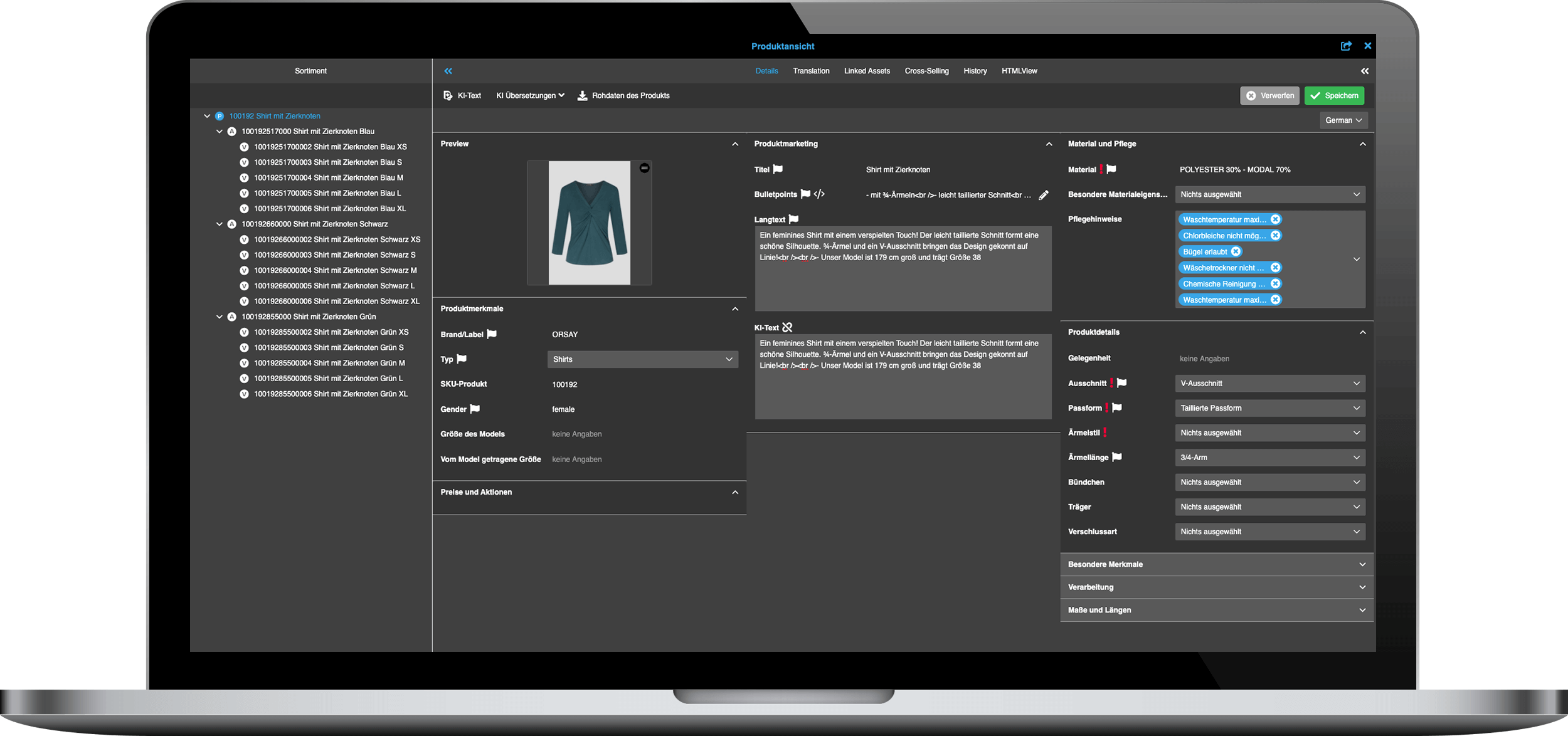The ultimate guide to online marketplaces: Everything you need to know
E-Commerce
Online marketplaces are popular with consumers and companies alike because they offer numerous advantages that simplify and optimise the purchasing process. In this blog article, we therefore take a closer look at online marketplaces. What are online marketplaces anyway, what advantages do they offer and which one is right for you? Of course, we will also show you how PIM and DAM systems can help you to organise your online market presence effectively.
What is an Online Marketplace?
A marketplace is a place where supply and demand meet – a concept that has existed since the Middle Ages. An online marketplace transfers this principle to the digital world: Instead of a physical place where people come together, the trading of goods and services takes place virtually. Buyers and sellers meet online on a specially created digital platform to present products and conduct business. The operator of the online marketplace acts as an intermediary and often also handles subsequent business transactions, such as payment transactions or shipping, which simplifies the purchasing process for both parties. Well-known examples of online marketplaces are Amazon, eBay, Etsy, Zalando or Alibaba, whereby Amazon and Zalando, for example, are not only intermediaries but also act as sellers themselves.

The importance of Online Marketplaces today
Online marketplaces have revolutionised retail and are now indispensable. They offer companies of all sizes an (additional) platform to sell their products and services digitally without having to bear the costs and effort of having their own online shop. The advantages are obvious:
- Easy access and a quick start: Getting started on online marketplaces is relatively easy, as the technical requirements and registration process are often straightforward. Companies can quickly create a seller account and place their products online without much effort, which enables immediate market access.
- Reach and visibility: Online marketplaces offer access to millions of potential customers worldwide. A small company can therefore compete with large brands and tap into new markets.
- Trust and familiarity: Large marketplaces enjoy the trust of consumers. Customers are more willing to buy products from a well-known platform as it generally stands for smooth processing, security and quality.
- Infrastructure and service: Many online marketplaces offer a comprehensive infrastructure that includes logistics and fulfilment services as well as integrated customer service. These services enable companies to handle the entire sales process efficiently and focus on their core business, while the marketplace takes care of order processing, shipping and customer support.
- Simple comparison options: Customers can compare prices and products directly on online marketplaces, which makes the purchasing decision process easier and often leads to faster sales.
- Round-the-clock availability and additional source of income: Online marketplaces are available 24/7 and offer a continuous source of income that enables sales at any time, regardless of normal opening hours.
- Personalised offers and recommendations: By using algorithms and artificial intelligence, online marketplaces can display personalised recommendations and special offers based on customers’ individual preferences and previous purchasing behaviour.
Despite all the advantages, it should be borne in mind that participation in an online marketplace also brings challenges, such as competition with other suppliers on the same platform, the price sensitivity of buyers or the payment of fees and commissions to the operator. This can also include the proper provision of the required product information if this is done manually rather than via a PIM system. But more on this later.
Types of Online Marketplaces
Before we go into which marketplace would be most suitable for your business and how you can identify it, let’s take a quick look at the four different types of online marketplaces:
- Vertical marketplace: Operator focusses on one industry or one product category. Examples: AutoScout24 (cars), Reverb (musical instruments) or Chrono24 (watches)
- Horizontal marketplace: Operator offers a wide range of products from the same product class (superordinate, same feature). Examples: Otto or Walmart
- Global marketplace: Operator offers almost everything and is aimed at a global clientele, often with multiple languages and currencies. Examples: Alibaba, Amazon or Etsy
- Hybrid marketplace: Operators offer both their own and third-party products, i.e. products from other manufacturers or retailers, on their online marketplace. Examples: App-Store, eBay or Amazon

How to find the right Online Marketplace
When you think of an online marketplace, Amazon immediately springs to mind – and no wonder, as Amazon now holds around 60 % of the German e-commerce market. However, Amazon is not automatically the best choice for every company. Depending on the type and scope of your products, it may also make sense to look at other online marketplaces. Niche marketplaces often offer decisive advantages that need to be taken into account. To find the right online marketplace for you, we have put together ten important points that can help you make the right choice.
- Target group and reach: Check whether your target group is active on the online marketplace, as a target group is more important than a generally high reach. Ideally, the marketplace should even offer you both: a high reach in the desired target group. This increases the chances of successful sales and minimises wastage.
- Costs and fees: Pay attention to the cost structure of the online marketplace, including listing fees, sales commissions and possible additional costs for advertising or premium services – after all, the marketplace operator is an intermediary and wants to be paid for the service. Compare the fees with the potential turnover to check the profitability. And bear in mind that not all online marketplaces work on a fixed-price basis (keyword: eBay or the highest bidder wins the auction).
- Competition and market presence: Analyse the competition on the online marketplace. Too much competition can make it harder to stand out, while niche marketplaces can be less crowded and thus offer advantages in not getting lost in all the competition.
- Marketplace requirements and guidelines: Check the requirements of the online marketplace with regard to product categories, image quality, delivery times and returns processing. Make sure that your company can easily fulfil the standards and guidelines.
- Sales and marketing tools: Investigate what sales promotion and marketing tools the online marketplace offers, such as adverts, discount promotions, and ways to improve product placement. These tools can be crucial to increasing your visibility.
- Technical integration and user-friendliness: The integration of your product catalogue and inventory management should function smoothly. Check whether the online marketplace enables a simple connection to existing systems such as PIM, ERP or your existing shop system and is also easy to use.
- Logistics and fulfilment options: Some online marketplaces offer their own fulfilment services that take care of shipping and customer support. This can save your company considerable time and effort.
- Customer support and service quality: The quality of the customer support provided by the online marketplace is important in order to obtain solutions quickly in the event of a problem. A reliable service can make the sales process much easier.
- Trust and reputation: Consider how the online marketplace is perceived by customers. A high trust factor can have a positive influence on purchasing behaviour and increase the conversion rate.
- Internationalisation options: If you want to sell internationally, check whether the online marketplace offers international selling options, including multilingualism, currency support and international shipping solutions.

What you need for a successful presence on an Online Marketplace
Like everything in life, success on an online marketplace depends on several factors that together create a strong market presence and attractive offers for customers. The quality of your products is beyond question, which is why we are not mentioning this point separately here. Here are the most important aspects that will help you to be successful on an online marketplace:
- High-quality product presentation: High-quality product photos, precise product descriptions and detailed information about your products are essential to convince potential buyers. Make sure that your product images look professional and show the products from different angles. Once the photo has aroused interest, your product descriptions need to be convincing. If they are up-to-date, correct and, above all, appealing, the first foundation stone has already been laid. This is because your potential customer relies on this product information to make a purchase decision in good conscience.
- Competitive prices and attractive offers: Prices can be compared incredibly quickly on online marketplaces. And honestly, why should a customer pay more for the same product? Therefore, analyse the price structures of your competitors on the online marketplace and adjust your prices accordingly. Use discount campaigns, special offers and volume discounts to increase the attractiveness of your products.
- Good customer service: Excellent customer service is an important success factor. After all, it is the only direct way in e-commerce to interact with your customers in the real world. Respond quickly to customer enquiries, provide helpful information and support your customers with problems. Positive customer service also leads to better reviews and increases the likelihood of repeat purchases.
- Positive reviews and customer feedback: Reviews play a major role in e-commerce, as the product cannot actually be inspected. The experiences and opinions of other customers therefore have a significant influence on the purchasing decision of potential buyers. Consequently, good reviews and feedback strengthen trust in your brand. Actively promote positive reviews by offering an excellent service and encouraging your customers to share their positive experiences.
- Efficient inventory and delivery management: Fast and flexible delivery has become the standard. It is therefore important not to lose sight of shipping, as delivery is sometimes a decisive factor in purchasing. Therefore, make sure that your stock levels are always up to date. Not only to avoid overselling, but so that you can actually deliver when the time comes. Fast delivery times and reliable shipping increase customer satisfaction and have a positive effect on your ratings.
- Targeted marketing measures: Use the advertising and marketing tools of the online marketplace to increase the visibility of your products. This can be done through sponsored adverts, discount campaigns or participation in special marketplace events.
- Data analysis and performance monitoring: Use the online marketplace’s analysis tools to monitor the performance of your products. Identify bestsellers and analyse which products are selling well and where there is potential for optimisation. Evaluate customer feedback and always keep an eye on market trends as part of your analyses.
- Strong brand presence and SEO: A clear brand strategy helps you to stand out from the competition. Use consistent branding that is tailored to your marketplace presence and communicate your unique selling points clearly and convincingly. Also use relevant keywords (headings, bullet points and product descriptions) to increase the visibility of your products in the search results of the online marketplace. Effective search engine optimisation helps to make your products easier to find and SEO optimisation on online marketplaces is often less complex than with search engines such as Google.
- Flexibility and adaptability: React flexibly to market changes, customer feedback and new trends. If market conditions or the requirements of the online marketplace change, you should also be prepared to adapt your strategies.
- Efficient use of PIM and DAM systems: With Product Information Management (PIM) and Digital Asset Management (DAM), you can efficiently manage your product information and media (e.g. images, videos or documents) and present them consistently on online marketplaces. This ensures a professional presentation and saves valuable time thanks to the automatic provision of data.
Why you should rely on PIM and DAM
By using PIM and DAM systems, you can not only efficiently manage your product data (classic master data such as item prices, technical specifications etc. as well as advertising texts) and digital assets (e.g. images, videos, documents etc.), you also fulfil the professional requirements of online marketplaces. This professionalism ensures an optimised presentation, better visibility and ultimately more success on the platforms. Here are the most important facts about how a PIM and DAM can help you to optimise your online marketplace:
- Centralised management of product information (PIM): A PIM system allows you to centrally manage all relevant product information such as descriptions, technical specifications, prices, availability and translations. You can easily update this information and have it automatically distributed to various online marketplaces, which saves you time and minimises errors.
- Consistency and quality of data (PIM): With a PIM system, you ensure that all product data is standardised and complete, regardless of the online marketplace on which the products are listed. Consistent and well-structured data increases the professionalism and credibility of your listings, which leads to a better perception among customers.
- Efficient digital media management (DAM): A DAM system organises and stores all your digital media such as images, videos and documents in one central location. You can easily edit, format and prepare your stored assets for the specific requirements of the various online marketplaces. This ensures that the right images are always used in the optimum quality.
- Quick adaptation to marketplace requirements (PIM and DAM): Different online marketplaces often have specific requirements for product data and media formats. PIM and DAM systems enable you to fulfil these requirements quickly by preparing the data and media themselves for specific channels and automatically adapting them to the respective standards.
- Improved search engine optimisation, SEO (PIM): With a PIM system, you can effectively integrate relevant keywords in product descriptions, titles and bullet points, which improves the findability of your products on online marketplaces. A good SEO strategy increases your visibility and chances of appearing at the top of search results.
- Fast market launches and updates (PIM and DAM): PIM and DAM systems enable you to bring new products to market faster and update existing offers easily. You make changes to prices, descriptions or media centrally and synchronise the updates simultaneously on all your online marketplaces where you are active.
- Reduction of errors and manual processes (PIM and DAM): By automating your data and media management, you minimise manual errors, which leads to a better product presentation and a more consistent brand presence. This saves you time and reduces your operating costs.
- Analysis and optimisation (PIM): A good PIM system often offers analysis tools that help you to monitor the performance of your products on the online marketplaces. This allows you to make data-based decisions to further optimise your product data and increase your sales.
When choosing a PIM and DAM system, it is usually advantageous to select systems that come from the same manufacturer. This not only ensures a smooth exchange between the two systems, which eliminates the need for interfaces. The same user interface also makes it easier to use the systems, as there is no need to familiarise yourself with two different systems.
OMN: The tool for successful product presentations in E-Commerce
Our specially developed OMN (Made in Germany!) fulfils all the functions you need to market your products in e-commerce. It is equipped with a PIM (management of your product data), a DAM (organisation of all your assets) and Channel Management (syndication of product data). OMN is also packed with the latest AI technology to automate time-consuming and costly manual processes during product communication.
OMN’s open interfaces ensure seamless integration into existing environments (e.g. online stores, marketplaces, ERP or CRM systems) to enable smooth data exchange between the systems. A proven PXM system of the latest generation!
We would be happy to convince you personally of OMN’s capabilities – free of charge and with no obligation:

Want to get to know OMN?
CONTACT US WITHOUT OBLIGATION AND LET US
CONVINCE YOU OF OUR OMN PIM AND OMN DAM.